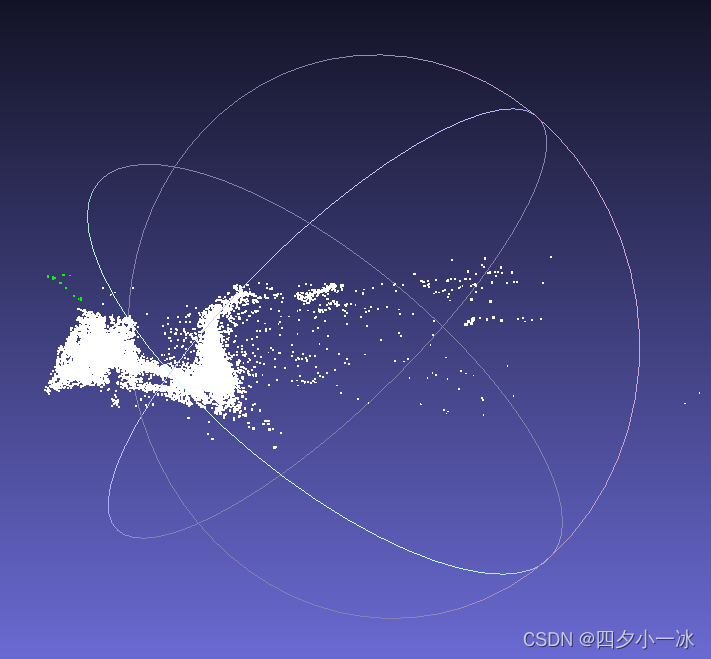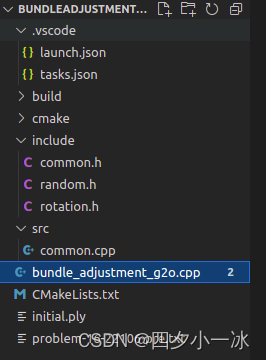视觉SLAM十四讲笔记-9-3
9.3 实践:Ceres BA
BAL 数据集提供了若干个场景,每一个场景里的相机和路标点信息由一个文本文件给定。在本例中,使用 problem-16-22106-pre.txt文件作为例子。数据格式参考官网:link
Data Format
Each problem is provided as a bzip2 compressed text file in the following format.
<num_cameras> <num_points> <num_observations>
<camera_index_1> <point_index_1> <x_1> <y_1>
...
<camera_index_num_observations> <point_index_num_observations> <x_num_observations> <y_num_observations>
<camera_1>
...
<camera_num_cameras>
<point_1>
...
<point_num_points>
首先,通过定义的 common.h 中定义的 BALProblem 类读入该文件的内容,然后分别用 Ceres 和 g2o 进行求解。
需要注意的是, BAL 数据集有其自身的特殊之处:
- BAL 的相机内参模型由焦距 f f f 和畸变参数 k 1 , k 2 k_1,k_2 k1,k2 给出。 f f f 类似于我们提到的 f x f_x fx 和 f y f_y fy 。由于照片像素基本上是正方形,所以在很多实际场合中 f x f_x fx] 非常接近于 f y f_y fy ,用同一个值也未尝不可。此外,这个模型没有 c x c_x cx 和 c y c_y cy,因为存储的数据已经去掉了这两个值。
- 因为BAL数据在投射时假设投影平面在相机光心之后,所以按照之前用的模型计算,需要在投影之后乘以系数 -1。不过,大部分数据集仍使用光心前面的投影平面,在使用数据集之前应该仔细阅读格式说明。
用 BALProblem 类读取数据之后,可以调用 Noemalize 函数对原始数据进行归一化,或者通过 Perturb 函数给数据加上噪声。归一化是指将所有路标点的中心置为零,然后做一个合适尺度的缩放。这会使得优化过程中数值更加稳定,防止在极端情况下处理很大或者有很大偏移的 BA 问题。
mkdir BundleAdjustmentCeres
cd BundleAdjustmentCeres/
code .

在 bundle_adjustment_ceres.cpp 文件中,实现了 Ceres 求解 BA 的过程。用 Ceres 的关键是定义出投影误差模型,该模型在 SnavelyReprojectionError.h 中给出。
//launch.json
{
// Use IntelliSense to learn about possible attributes.
// Hover to view descriptions of existing attributes.
// For more information, visit: https://go.microsoft.com/fwlink/?linkid=830387
"version": "0.2.0",
"configurations": [
{
"name": "g++ - 生成和调试活动文件",
"type": "cppdbg",
"request":"launch",
"program":"${workspaceFolder}/build/bundle_adjustment_ceres",
"args": [],
"stopAtEntry": false,
"cwd": "${workspaceFolder}",
"environment": [],
"externalConsole": false,
"MIMode": "gdb",
"setupCommands": [
{
"description": "为 gdb 启动整齐打印",
"text": "-enable-pretty-printing",
"ignoreFailures": true
}
],
"preLaunchTask": "Build",
"miDebuggerPath": "/usr/bin/gdb"
}
]
}
//tasks.json
{
"version": "2.0.0",
"options":{
"cwd": "${workspaceFolder}/build" //指明在哪个文件夹下做下面这些指令
},
"tasks": [
{
"type": "shell",
"label": "cmake", //label就是这个task的名字,这个task的名字叫cmake
"command": "cmake", //command就是要执行什么命令,这个task要执行的任务是cmake
"args":[
".."
]
},
{
"label": "make", //这个task的名字叫make
"group": {
"kind": "build",
"isDefault": true
},
"command": "make", //这个task要执行的任务是make
"args": [
]
},
{
"label": "Build",
"dependsOrder": "sequence", //按列出的顺序执行任务依赖项
"dependsOn":[ //这个label依赖于上面两个label
"cmake",
"make"
]
}
]
}
#CMakeLists.txt
cmake_minimum_required(VERSION 3.0)
project(BUNDLEADJUSTMENTCERES)
#在g++编译时,添加编译参数,比如-Wall可以输出一些警告信息
set(CMAKE_CXX_FLAGS "${CMAKE_CXX_FLAGS} -Wall -std=c++14")
LIST(APPEND CMAKE_MODULE_PATH ${PROJECT_SOURCE_DIR}/cmake)
#一定要加上这句话,加上这个生成的可执行文件才是可以Debug的,不然不加或者是Release的话生成的可执行文件是无法进行调试的
set(CMAKE_BUILD_TYPE Debug)
# Eigen
include_directories("/usr/include/eigen3")
#添加头文件
include_directories(include)
#此工程要调用opencv库,因此需要添加opancv头文件和链接库
#寻找OpenCV库
find_package(OpenCV REQUIRED)
#添加头文件
include_directories(${OpenCV_INCLUDE_DIRS})
find_package(CSparse REQUIRED)
include_directories(${CSPARSE_INCLUDE_DIR})
#find Ceres
find_package(Ceres REQUIRED)
include_directories(${CERES_INCLUDE_DIRS})
add_library(bal_common src/common.cpp)
add_executable(bundle_adjustment_ceres bundle_adjustment_ceres.cpp)
#链接OpenCV库
target_link_libraries(bundle_adjustment_ceres ${OpenCV_LIBS} ${CERES_LIBRARIES} bal_common)
//SnavelyReprojectionError.h
/*
该文件给出了投影误差模型
*/
#ifndef SnavelyReprojection_H
#define SnavelyReprojection_H
#include <iostream>
#include "ceres/ceres.h"
#include "rotation.h"
class SnavelyReprojectionError {
public:
SnavelyReprojectionError(double observation_x, double observation_y) : observed_x(observation_x),
observed_y(observation_y) {}
//括号运算符,实现了Ceres计算投影误差的接口
template<typename T>
bool operator()(const T *const camera,
const T *const point,
T *residuals) const {
// camera[0,1,2] are the angle-axis rotation
T predictions[2];
// 带畸变系数的相机投影过程得到路标点在图像上的像素坐标估计值
CamProjectionWithDistortion(camera, point, predictions);
// 观测值与估计值的误差
residuals[0] = predictions[0] - T(observed_x);
residuals[1] = predictions[1] - T(observed_y);
return true;
}
// 每个相机用9维的参数来描述,camera : 9 dims array
// camera : 9 dims array
// [0-2] : angle-axis rotation 三维的旋转角
// [3-5] : translateion 三维的平移向量
// [6-8] : camera parameter, [6] focal length 一维的焦距, [7-8] second and forth order radial distortion 两维的畸变系数
// point : 3D location.
// predictions : 2D predictions with center of the image plane.
template<typename T>
static inline bool CamProjectionWithDistortion(const T *camera, const T *point, T *predictions) {
// Rodrigues' formula 罗德里格斯公式
T p[3];
AngleAxisRotatePoint(camera, point, p);
// camera[3,4,5] are the translation
// 取出9维相机参数Camera中的平移部分,第3~5
p[0] += camera[3];
p[1] += camera[4];
p[2] += camera[5];
// Compute the center fo distortion计算用于畸变的中心点坐标
T xp = -p[0] / p[2];
T yp = -p[1] / p[2];
// Apply second and fourth order radial distortion两维的畸变系数
const T &l1 = camera[7];
const T &l2 = camera[8];
T r2 = xp * xp + yp * yp;
// 应用二阶和四阶径向畸变系数
T distortion = T(1.0) + r2 * (l1 + l2 * r2);
// 获取相机焦距
const T &focal = camera[6];
// 计算畸变后的像素坐标
predictions[0] = focal * distortion * xp;
predictions[1] = focal * distortion * yp;
return true;
}
// 静态函数Create作为外部调用接口,直接返回一个可自动求导的Ceres代价函数
static ceres::CostFunction *Create(const double observed_x, const double observed_y) {
return (new ceres::AutoDiffCostFunction<SnavelyReprojectionError, 2, 9, 3>(
// 重投影误差代价函数的计算模型
new SnavelyReprojectionError(observed_x, observed_y)));
}
private:
double observed_x;
double observed_y;
};
#endif // SnavelyReprojection.h
在类的括号中实现了 Ceres 计算误差的接口,估计数据通过 CamProjectionWithDistortion 函数中得到。注意在 Ceres 中,必须以 double 数组形式存储优化变量。该类的静态函数 Create 作为外部调用接口,直接返回一个可自动求导的 Ceres 代价函数。
只需要调用 Create 函数,把代价函数放入 ceres::Problem 中即可。
然后,在 bundle_adjustment_ceres.cpp 中实现了 BA 搭建和求解的部分:
//bundle_adjustment_ceres.cpp
#include <iostream>
#include <ceres/ceres.h>
#include "common.h"
#include "SnavelyReprojectionError.h"
using namespace std;
void SolveBA(BALProblem &bal_problem);
int main(int argc, char **argv)
{
string file = "./problem-16-22106-pre.txt";
BALProblem bal_problem(file);
//数据归一化
bal_problem.Normalize();
//给数据添加噪声
bal_problem.Perturb(0.1, 0.5, 0.5);
bal_problem.WriteToPLYFile("initial.ply");
SolveBA(bal_problem);
bal_problem.WriteToPLYFile("final.ply");
return 0;
}
void SolveBA(BALProblem &bal_problem) {
const int point_block_size = bal_problem.point_block_size();
const int camera_block_size = bal_problem.camera_block_size();
double *points = bal_problem.mutable_points(); //获得待优化系数3d点 points指向3d点的首地址
double *cameras = bal_problem.mutable_cameras();//获得待优化系数相机 cameras指向相机的首地址
// Observations is 2 * num_observations long array observations
// [u_1, u_2, ... u_n], where each u_i is two dimensional, the x
// and y position of the observation.
const double *observations = bal_problem.observations();
//定义问题
ceres::Problem problem;
for (int i = 0; i < bal_problem.num_observations(); ++i) {
ceres::CostFunction *cost_function;
// Each Residual block takes a point and a camera as input
// and outputs a 2 dimensional Residual
//代价函数,使用静态函数Create返回的可自动求导的代价函数
cost_function = SnavelyReprojectionError::Create(observations[2 * i + 0], observations[2 * i + 1]);
// If enabled use Huber's loss function.
ceres::LossFunction *loss_function = new ceres::HuberLoss(1.0);//核函数
// Each observation corresponds to a pair of a camera and a point
// which are identified by camera_index()[i] and point_index()[i]
// respectively.
//bal_Problem.point_index()这返回的是一个地址指向索引号的首地址
double *camera = cameras + camera_block_size * bal_problem.camera_index()[i];
double *point = points + point_block_size * bal_problem.point_index()[i];
//向问题中添加误差项
problem.AddResidualBlock(cost_function, loss_function, camera, point);
}
// show some information here ...
std::cout << "bal problem file loaded..." << std::endl;
std::cout << "bal problem have " << bal_problem.num_cameras() << " cameras and "
<< bal_problem.num_points() << " points. " << std::endl;
std::cout << "Forming " << bal_problem.num_observations() << " observations. " << std::endl;
std::cout << "Solving ceres BA ... " << endl;
ceres::Solver::Options options; // 设定ceres求解的配置选项
options.linear_solver_type = ceres::LinearSolverType::SPARSE_SCHUR; // 设置舒尔消元/边缘化,便于加速求解
options.minimizer_progress_to_stdout = true;
ceres::Solver::Summary summary; // 优化信息
ceres::Solve(options, &problem, &summary); // 开始执行优化
std::cout << summary.FullReport() << "\n";
}
在 ceres::Solver::Options 中,可以设定求解的方法。使用 SPARSE_SCHUR 会让 Ceres 实际求解的过程和前面描述的一样,即先对路标部分进行 Schur 边缘化,以加速的方式求解此问题。不过,在 Ceres 中不能控制哪部分变量被边缘化,这是由 Ceres 求解器自动寻找并计算。
BA 优化的求解输出如下:

用 Meshlab 打开两个点云:


9.4 实践:g2o求解BA
g2o 求解 BA 问题时,使用图模型来描述问题的结构,所以需要用节点来表示相机和路标,然后用边表示它们之间的观测。仍然使用自定义的点和边,只需要覆盖一些关键函数即可。针对相机和路标,定义如下结构体,并使用 override 关键字对基类虚函数进行覆盖:
mkdir BundleAdjustmentG2o
cd BundleAdjustmentG2o
code .

//launch.json
{
// Use IntelliSense to learn about possible attributes.
// Hover to view descriptions of existing attributes.
// For more information, visit: https://go.microsoft.com/fwlink/?linkid=830387
"version": "0.2.0",
"configurations": [
{
"name": "g++ - 生成和调试活动文件",
"type": "cppdbg",
"request":"launch",
"program":"${workspaceFolder}/build/bundle_adjustment_g2o",
"args": [],
"stopAtEntry": false,
"cwd": "${workspaceFolder}",
"environment": [],
"externalConsole": false,
"MIMode": "gdb",
"setupCommands": [
{
"description": "为 gdb 启动整齐打印",
"text": "-enable-pretty-printing",
"ignoreFailures": true
}
],
"preLaunchTask": "Build",
"miDebuggerPath": "/usr/bin/gdb"
}
]
}
//tasks.json
{
"version": "2.0.0",
"options":{
"cwd": "${workspaceFolder}/build" //指明在哪个文件夹下做下面这些指令
},
"tasks": [
{
"type": "shell",
"label": "cmake", //label就是这个task的名字,这个task的名字叫cmake
"command": "cmake", //command就是要执行什么命令,这个task要执行的任务是cmake
"args":[
".."
]
},
{
"label": "make", //这个task的名字叫make
"group": {
"kind": "build",
"isDefault": true
},
"command": "make", //这个task要执行的任务是make
"args": [
]
},
{
"label": "Build",
"dependsOrder": "sequence", //按列出的顺序执行任务依赖项
"dependsOn":[ //这个label依赖于上面两个label
"cmake",
"make"
]
}
]
}
#CMakeLists.txt
cmake_minimum_required(VERSION 3.0)
project(BUNDLEADJUSTMENTG2O)
#在g++编译时,添加编译参数,比如-Wall可以输出一些警告信息
set(CMAKE_CXX_FLAGS "${CMAKE_CXX_FLAGS} -Wall -std=c++14")
LIST(APPEND CMAKE_MODULE_PATH ${PROJECT_SOURCE_DIR}/cmake)
#一定要加上这句话,加上这个生成的可执行文件才是可以Debug的,不然不加或者是Release的话生成的可执行文件是无法进行调试的
set(CMAKE_BUILD_TYPE Debug)
find_package(Sophus REQUIRED)
include_directories( ${Sophus_INCLUDE_DIRS} )
# Eigen
include_directories("/usr/include/eigen3")
#添加头文件
include_directories(include)
find_package(OpenCV REQUIRED)
include_directories(${OpenCV_INCLUDE_DIRS})
find_package(CSparse REQUIRED)
include_directories(${CSPARSE_INCLUDE_DIR})
find_package (glog 0.6.0 REQUIRED)
#find g2o
find_package(G2O REQUIRED)
include_directories(${G2O_INCLUDE_DIRS})
SET(G2O_LIBS g2o_csparse_extension g2o_stuff g2o_core cxsparse)
add_library(bal_common src/common.cpp)
add_executable(bundle_adjustment_g2o bundle_adjustment_g2o.cpp)
#链接OpenCV库
target_link_libraries(bundle_adjustment_g2o Sophus::Sophus ${OpenCV_LIBS} ${G2O_LIBS} bal_common glog::glog)
#include <g2o/core/base_vertex.h>
#include <g2o/core/base_binary_edge.h>
#include <g2o/core/block_solver.h>
#include <g2o/core/optimization_algorithm_levenberg.h>
#include <g2o/solvers/csparse/linear_solver_csparse.h>
#include <g2o/core/robust_kernel_impl.h>
#include <iostream>
#include "common.h"
#include "sophus/se3.hpp"
using namespace Sophus;
using namespace Eigen;
using namespace std;
/// 姿态和内参的结构
struct PoseAndIntrinsics {
PoseAndIntrinsics() {}
/// set from given data address
// 构造函数:从给定的数据地址中解析出9维数据
explicit PoseAndIntrinsics(double *data_addr) {
rotation = SO3d::exp(Vector3d(data_addr[0], data_addr[1], data_addr[2])); // so3类型旋转位姿
translation = Vector3d(data_addr[3], data_addr[4], data_addr[5]); // 平移向量
focal = data_addr[6]; // 焦距
k1 = data_addr[7]; // 畸变系数1
k2 = data_addr[8]; // 畸变系数2
}
/// 将估计值放入内存
void set_to(double *data_addr) {
auto r = rotation.log();
for (int i = 0; i < 3; ++i) data_addr[i] = r[i];
for (int i = 0; i < 3; ++i) data_addr[i + 3] = translation[i];
data_addr[6] = focal;
data_addr[7] = k1;
data_addr[8] = k2;
}
SO3d rotation;
Vector3d translation = Vector3d::Zero();
double focal = 0;
double k1 = 0, k2 = 0;
};
/// 位姿加相机内参的顶点,9维,前三维为so3,接下去为t, f, k1, k2
// 定义位姿加相机内参的顶点,9维,前三维为so3旋转位姿,接下去为平移向量t, 焦距f, 畸变系数k1, 畸变系数k2
class VertexPoseAndIntrinsics : public g2o::BaseVertex<9, PoseAndIntrinsics> {
public:
EIGEN_MAKE_ALIGNED_OPERATOR_NEW;
VertexPoseAndIntrinsics() {}
// 位姿顶点的重置函数:将估计值置零
virtual void setToOriginImpl() override {
_estimate = PoseAndIntrinsics();
}
// 位姿顶点的更新函数:计算9维参数的增量 x_{k+1} = x_{k} + \Delta x
virtual void oplusImpl(const double *update) override {
// 旋转:【左乘李代数形式扰动更新量】
_estimate.rotation = SO3d::exp(Vector3d(update[0], update[1], update[2])) * _estimate.rotation;
// 平移:与更新量直接相加
_estimate.translation += Vector3d(update[3], update[4], update[5]);
// 焦距:与更新量直接相加
_estimate.focal += update[6];
// 畸变系数1:与更新量直接相加
_estimate.k1 += update[7];
// 畸变系数2:与更新量直接相加
_estimate.k2 += update[8];
}
/// 根据估计值投影一个点
Vector2d project(const Vector3d &point) {
// 对空间中的路标点进行旋转平移,从世界坐标系转换到相机坐标系
Vector3d pc = _estimate.rotation * point + _estimate.translation;
// 相机坐标系投影到归一化平面上
//【因为BAL数据集的数据在投影使,假设了投影平面在相机光心之后,需要在投影之后乘以系数-1】
pc = -pc / pc[2];
// 计算二范数
double r2 = pc.squaredNorm();
// 计算畸变系数
double distortion = 1.0 + r2 * (_estimate.k1 + _estimate.k2 * r2);
// 获取畸变后的真实图像像素坐标
return Vector2d(_estimate.focal * distortion * pc[0],
_estimate.focal * distortion * pc[1]);
}
virtual bool read(istream &in) {}
virtual bool write(ostream &out) const {}
};
//定义路标顶点类型
class VertexPoint : public g2o::BaseVertex<3, Vector3d> {
public:
EIGEN_MAKE_ALIGNED_OPERATOR_NEW;
VertexPoint() {}
// 路标点顶点的估计值置零
virtual void setToOriginImpl() override {
_estimate = Vector3d(0, 0, 0);
}
// 计算更新后的路标点 x_{k+1} = x_{k} + \Delta x,路标点位置直接与更新量相加
virtual void oplusImpl(const double *update) override {
_estimate += Vector3d(update[0], update[1], update[2]);
}
virtual bool read(istream &in) {}
virtual bool write(ostream &out) const {}
};
// 定义重投影误差边的类型:派生自二元基边
class EdgeProjection :
public g2o::BaseBinaryEdge<2, Vector2d, VertexPoseAndIntrinsics, VertexPoint> {
public:
EIGEN_MAKE_ALIGNED_OPERATOR_NEW;
// 计算重投影误差
virtual void computeError() override {
// 取出误差边所连接的两个顶点:位姿顶点和路标顶点
auto v0 = (VertexPoseAndIntrinsics *) _vertices[0];
auto v1 = (VertexPoint *) _vertices[1];
// 计算路标顶点v1在当前相机v0上的投影估计值
auto proj = v0->project(v1->estimate());
// 估计值与观测值作差
_error = proj - _measurement;
}
// use numeric derivatives
virtual bool read(istream &in) {}
virtual bool write(ostream &out) const {}
};
void SolveBA(BALProblem &bal_problem);
int main(int argc, char **argv) {
// if (argc != 2) {
// cout << "usage: bundle_adjustment_g2o bal_data.txt" << endl;
// return 1;
// }
string file = "./problem-16-22106-pre.txt";
BALProblem bal_problem(file);
bal_problem.Normalize();
bal_problem.Perturb(0.1, 0.5, 0.5);
bal_problem.WriteToPLYFile("initial.ply");
SolveBA(bal_problem);
bal_problem.WriteToPLYFile("final.ply");
return 0;
}
void SolveBA(BALProblem &bal_problem) {
const int point_block_size = bal_problem.point_block_size();
const int camera_block_size = bal_problem.camera_block_size();
double *points = bal_problem.mutable_points();
double *cameras = bal_problem.mutable_cameras();
// pose dimension 9, landmark is 3
// 9x3 的块求解器:相机位姿 9 维(旋转3维,平移3维,焦距1维,畸变系数2维), 路标点 3 维
typedef g2o::BlockSolver<g2o::BlockSolverTraits<9, 3>> BlockSolverType;
// 线性求解器
typedef g2o::LinearSolverCSparse<BlockSolverType::PoseMatrixType> LinearSolverType;
// use LM
// 选择【列文伯格-马夸尔特LM算法】进行最小二乘梯度下降的优化迭代
auto solver = new g2o::OptimizationAlgorithmLevenberg(
g2o::make_unique<BlockSolverType>(g2o::make_unique<LinearSolverType>()));
// 稀疏优化器
g2o::SparseOptimizer optimizer;
// 为稀疏优化器设置 LM 优化算法
optimizer.setAlgorithm(solver);
// 打开调试输出
optimizer.setVerbose(true);
/// build g2o problem
// 构建 g2o 图优化模型
const double *observations = bal_problem.observations();
// vertex 相机位姿顶点集合
vector<VertexPoseAndIntrinsics *> vertex_pose_intrinsics;
// 路标顶点集合
vector<VertexPoint *> vertex_points;
// 将相机顶点加入到优化器中
for (int i = 0; i < bal_problem.num_cameras(); ++i) {
// 相机位姿顶点
VertexPoseAndIntrinsics *v = new VertexPoseAndIntrinsics();
// 获取当前第 i 个相机位姿 9 维
double *camera = cameras + camera_block_size * i;
// 给该相机位姿顶点设置编号ID
v->setId(i);
// 设置相机位姿顶点的估计值
v->setEstimate(PoseAndIntrinsics(camera));
// 往图模型稀疏优化器中添加该位姿顶点
optimizer.addVertex(v);
vertex_pose_intrinsics.push_back(v);
}
// 将路标顶点加入到优化器中
for (int i = 0; i < bal_problem.num_points(); ++i) {
// 路标点顶点
VertexPoint *v = new VertexPoint();
// 获取当前第 i 个路标点位置 3 维
double *point = points + point_block_size * i;
// 设置路标顶点的编号ID,排在在所有相机的序号之后
v->setId(i + bal_problem.num_cameras());
// 给该路标顶点设置估计值
v->setEstimate(Vector3d(point[0], point[1], point[2]));
// g2o在BA中需要手动设置待Marg的顶点,// 【将路标顶点边缘化,Schur舒尔消元】
v->setMarginalized(true);
// 往图模型稀疏优化器中添加该路标顶点
optimizer.addVertex(v);
vertex_points.push_back(v);
}
// edge
// 将观测的重投影误差边加入到优化器中
for (int i = 0; i < bal_problem.num_observations(); ++i) {
// 重投影误差边
EdgeProjection *edge = new EdgeProjection;
// 设置误差边所连接的0号顶点:相机位姿顶点
edge->setVertex(0, vertex_pose_intrinsics[bal_problem.camera_index()[i]]);
// 设置误差边所连接的1号顶点:路标顶点
edge->setVertex(1, vertex_points[bal_problem.point_index()[i]]);
// 设置误差边的观测值
edge->setMeasurement(Vector2d(observations[2 * i + 0], observations[2 * i + 1]));
// 设置信息矩阵为 2x2 的单位阵
edge->setInformation(Matrix2d::Identity());
// 鲁棒核函数设置为Huber核,用于保证每条误差边不会太大而掩盖了其它的误差边,可以使优化结果更加稳健。
edge->setRobustKernel(new g2o::RobustKernelHuber());
// 往图模型稀疏优化器中添加重投影误差边
optimizer.addEdge(edge);
}
// 优化器初始化
optimizer.initializeOptimization();
// 执行40次优化迭代
optimizer.optimize(40);
// set to bal problem
// 将优化后的相机位姿存入内存中
for (int i = 0; i < bal_problem.num_cameras(); ++i) {
// 第i个相机
double *camera = cameras + camera_block_size * i;
auto vertex = vertex_pose_intrinsics[i];
// 用优化后的相机位姿顶点进行更新
auto estimate = vertex->estimate();
// 写入内存
estimate.set_to(camera);
}
for (int i = 0; i < bal_problem.num_points(); ++i) {
// 第i个路标点
double *point = points + point_block_size * i;
// 用优化后的路标顶点进行更新
auto vertex = vertex_points[i];
for (int k = 0; k < 3; ++k) point[k] = vertex->estimate()[k];
}
}
运行结果如下:

用 Meshlab 打开两个点云:


g2o 和 Ceres 的一大不同之处在于,在使用系数优化时, g2o 必须手动设置哪些顶点为边缘顶点,否则就会报运行错误。其余地方和 Ceres 实验大同小异。
在只有观测方程的情况下,构建最小二乘问题,对位姿和路标同时做调整,即所谓的 BA。





















 1618
1618











 被折叠的 条评论
为什么被折叠?
被折叠的 条评论
为什么被折叠?








